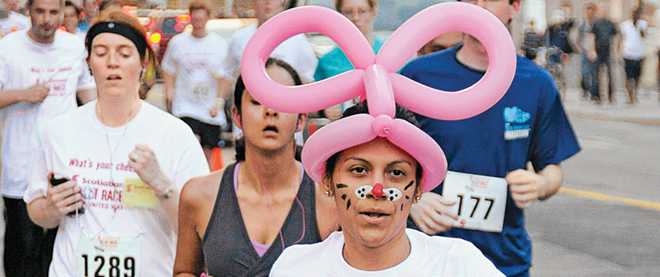Buy, sell, donate
A new breed of analysts is using investing techniques to better scrutinize the booming charity business
Dominic Chan/CP
Share

When the news first broke a few weeks ago that the Canadian Cancer Society spends more money fundraising than it does on cancer research, it set off alarm bells for many of the charity’s donors. Shortly after, the Canadian Press dug through tax filings of the country’s many registered charities and found that thousands of employees earn hefty six-figure salaries. The revelations raised questions about how charitable organizations use the money people give them. Which is why some say it’s time to start evaluating charities with the same unforgiving eye that equity analysts bring to valuing stocks.
“We could have a far more effective charitable sector than we have now, if funds are redirected properly,” says Greg Thomson, director of research at Charity Intelligence Canada, a Toronto organization that rates charities on their performance. “We’re trying to make it more market driven so that the charities doing a good job get more money and can expand, and the charities that aren’t are forced to pull up their socks.”
That’s not the type of language one normally associates with philanthropy. Neither are terms like return on investment, cost-coverage ratios and operating efficiencies—just a few of the measures this new breed of charity analysts like Thomson is using to scrutinize charities. While it may seem like there’s little in common between for-profit companies and philanthropy, the charity sector has become a big business. Last year, Canadians donated $6.5 billion and the sector employs more than one million people.
The problem is that many big charities have been caught up in a “fundraising arms race,” says Thomson, outdoing each other with ever more high-profile events and campaigns. For instance, charity lotteries have become huge, competitive affairs. Yet last year only $3.69 of every $100 the Cancer Society raised through its lottery trickled through to the charity—the rest went to pay for prizes and marketing.
In the past, people typically gave their money to whatever big charities garnered the most media attention, but there are signs donors are becoming more selective. Part of the shift is due to the recession, which has made money scarce. And just as technology has led to fragmentation in other industries, large charities face competition from enterprising upstarts. With the spread of social networks like Facebook there are never-ending requests to support runs for this and walks for that, all competing for the same charity dollars. Today there are roughly 85,000 charitable organizations vying for Canadians’ money, up from 63,000 in the early 1990s and nearly double the number that existed three decades ago.
Against that backdrop, more donors, foundations and corporations looking to make gifts are turning to third-party analysts like Charity Intelligence and others to find the most worthy candidates. As the trend toward performance-based giving grows, it’s also drawing critics. Mark Blumberg, a lawyer specializing in the sector, says rating and ranking charities like stocks fails to capture the complexities of the sector. “If you use strictly business techniques to analyze a charity, a bad charity can look good and a good one can look bad,” warns Blumberg. For one thing, publicly traded companies face serious repercussions if they provide misleading disclosures, but a charity can make any claim it wants, potentially distorting the analysis.
Blumberg says a charity’s value also goes far beyond its financial statements, since many rely heavily on donations of materials and volunteer time. For its part, the Cancer Society defends how it allocates money. In a statement following the CBC-TV Marketplace investigation into its spending, the agency said its fundraising supports its mission of “eradicating cancer and improving the quality of life for people with cancer and their families.” When asked to comment on the trend toward performance-based giving, the Cancer Society referred to a statement put out by Imagine Canada, an advocacy group that works on behalf of charities. Imagine warned that a performance ranking “does not provide complete and contextual information…Even organizations doing similar work are difficult to compare given the variations in populations served and communities in which they work.”
Charity Intelligence (which is itself a registered charity) says it can overcome the challenges inherent in valuing charitable groups by inviting management to discuss their operations in depth. When hard figures aren’t available, Thomson and his colleagues do what equity analysts often do—make assumptions, such as ascribing a $15-an-hour value to the time volunteers put in. Thomson also says there’s more to charity analysis than crunching numbers. For instance, many groups tackle the problem of drug and alcohol abuse. To determine which ones to recommend, Charity Intelligence attempts to determine the average national rate of people coming out of programs sober. It then looks for those charities that produce better results for roughly the same amount of money.
In other words, analyzing charities is far more complex than slapping a “buy” or “sell” recommendation on a stock. But with billions of dollars at stake, charities shouldn’t be surprised if more donors want to put their operations under the microscope.